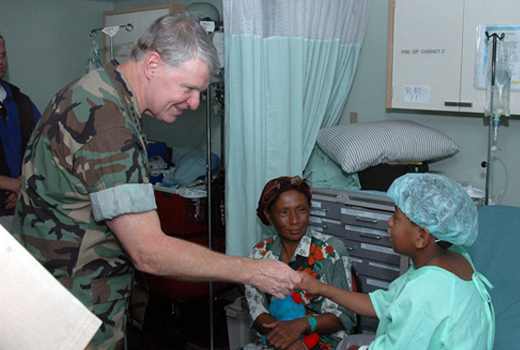Winning Hearts & Minds: A Conversation with Admiral Gary Roughead
Few people understand “smart” power as well as Chief of Naval Operations (CNO) Admiral Gary Roughead. To this ingenious, adept leader of the world’s largest and most powerful navy, it’s not just about military strategy or political science; it’s about heart. It’s about the measure of a man with regard to honor, courage and commitment. And, it’s about appreciation and respect for the natural world. As one of the U.S. Defense Department’s most powerful decision-makers, Roughead has helped mold a new breed of Sailor who understands that preventing war is just as important as winning war – that creating partners is more important than creating opponents. Add mission mandates such as humanitarian assistance, disaster relief and environmental stewardship, and it’s clear why Roughead and his brand of smart power are having a profound impact on international peace, national security and natural security.
Engendering Environmental Advocacy
“You don’t live on the ocean and not love it. My appreciation for the environment came from a very early age – from just loving to be on the water. It’s something that’s had a very strong impact on me,” explains Roughead, who grew up in North Africa where his father worked in the oil business. He and his family lived along an uninhabited area of coastline where his father’s company built a power plant and refinery to process and transport Libya’s huge oil field finds to offshore tankers.
“We were the first people to move there; I was still in grammar school. The beauty in being the first was that the coastline was absolutely pristine. Even before school, I would get up and go skin diving. There were beautiful reefs, and fish were everywhere. The vegetation was just incredible. The company built an offshore loading area a few miles off the beach with 36-inch pipes pumping crude oil out to where these big supertankers would come in. Back then, there wasn’t a high regard for the environment, so when storms would kick-up and ships got underway in a hurry, they would just cast them off and all that oil would go into the ocean.
“Fast forward about five years, and the last time I went skin diving I didn’t see a living thing. The vegetation was dead. At that time I was visiting my folks on summer leave from the Naval Academy. There were periods when I would skin dive and then surface after being down about 35-40 feet, and my lungs would be ready to burst. I’d look up, having moved from my original location, and see this massive oil slick. And, I’d go, ‘Oh gosh . . . no!’ But, you didn’t have any choice. I would come home and actually have to clean the oil off with kerosene because it was caked on me.
“I saw and experienced environmental devastation, and it had an effect on me. Being at sea all the time – I love going to sea and seeing everything about it – drove me to the views I have. I really do think there’s compatibility between the Navy and the environment. We have things we must accomplish, but we can do them cleanly and responsibly. That’s what we’ve tried to demonstrate to those who have different views – that there has to be compatibility between the two.
Creating a Culture of Caring
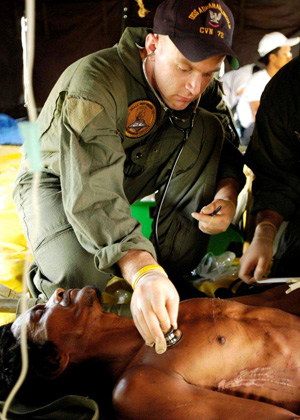
U.S. Navy photo by Photographer’s Mate Airman Jordon R. Beesley
“I’ve been doing this a long time – 38 years. My experience is that very rarely in the Navy do you find anyone who’s not giving everything they can. It doesn’t make any difference whose job it may be; if something has to be done, we get it done. That’s the Navy culture, and it’s derived from going to sea. If someone is in trouble, you act and put differences aside or sort them out later.
“An example of this was when I was a younger officer at the height of the cold war. We were going into the Black Sea, which was the Soviet Union’s backyard. We started very early in the morning because it’s a long, busy transit, and we broke out in the Black Sea early evening in two U.S. ships. Of course, the Soviets were there waiting for us because they know you’re coming . . .
“We had a Sailor on the other ship who injured his eye – a piece of metal flew into it – and the doctor was on our ship. So, we stopped – all this cold war tension; we’re coming into their backyard; they’re waiting for us, and we knew they’d be with us the whole way around – and we stop. The injured Sailor gets into a small boat from the other ship with a big bandage on his head, and it’s motoring toward us. I was on watch on the bridge, and a flashing light from the Soviet ship said, ‘Do you need medical assistance?’ There’s this incredible divide with our ships at sea and yet, ‘Can I help you?’ We all do that – Sailors from every nation. A Sailor is a Sailor no matter where he/she comes from. And so, whether you’re at sea or at shore, if someone is struggling with something, invariably you’ll see a Sailor come up and say, ‘How can I help you?’
Turning Disadvantages into Advantages
“One of the great breakthroughs we’ve had with non-governmental organizations (NGOs) was the 2004 Indonesian tsunami. We had dealings with NGOs before – there were a few very close to us – but the tsunami of ‘04 was such a horrendous event that it didn’t make any difference who you were. It required everybody. The way we were able to work together broke the ice. Since that time we’ve been holding Navy/NGO conferences, and the number of attendees continues to go up. The number of NGOs that like to work with us is increasing, and the number of NGOs leery of us is decreasing. I think it’s about getting to know one another. Also, one thing I learned from the tsunami was that there’s a lot to understand about NGOs, particularly in disaster relief (DR) and humanitarian assistance (HA).
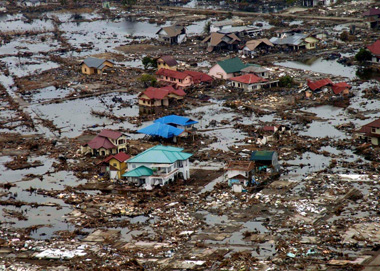
U.S. Navy photo by Photographer’s Mate 2nd Class Philip A. McDaniel
“Some of the things the Navy brings to DR/HA is our ability to mobilize a lot of ‘stuff’ rapidly, to get there quickly and to provide some initial relief. But, our job isn’t really recovery. The NGOs are suited to that. They man and prepare for it. It’s important the Navy realizes that. We’re not there to take over and do the whole thing. It’s a marriage, but everyone has to understand that. During the tsunami, my ‘ah-hah’ moment was when I had a UN (United Nations) guy and a USAID (U.S. Agency for International Development) representative, and we brought them into all our Navy planning meetings. In fact, our Command Center was at a classification level too high for the NGOs, so we reduced it so they could come in.
“We were in a meeting talking about doing this and that, and the first time I heard the USAID rep speak up, he said, ‘That’s not a good idea.’ We all looked at him and said, ‘Why is that?’ He said, ‘That’s not the NGOs’ doctrine.’ I said, ‘What do you mean?’ And he said, ‘There’s a very clear doctrine that NGOs operate under. These are the protocols.’ We all kind of took a training time-out from him when he said, ‘No, this is how it is; this is how it lays out. You can go in and be the thousand pound gorilla, if you want. But, if you understand what they need you to be able to do, then it will work out fine.’ So, that’s what we did. Tragically, that event was a great learning experience for us. Since that time, we’ve really taken off on proactive humanitarian assistance.
“From 2005 ‘til last summer we’ve assisted more than one-half million patients from our ships. It’s about people caring for people, and it’s the right thing to do. We also get ancillary benefits such as developing relationships that otherwise wouldn’t happen. And, especially for the young generation that serves today, it’s hugely gratifying. If you talk to any of the young Sailors coming back, it’s a life-changing experience. For me, the tsunami was one of the most significant personal and professional things that’s ever happened in my life. It was a huge tragedy; there’s no question about it. But, what I believe we were able to do and how we came together with so many other countries and organizations was really extraordinary.
Changing Lives for the Better
“A few years ago when the hospital ship Comfort was returning from one of its humanitarian deployments in Central and South America, I flew down to Miami/Ft. Lauderdale and jumped onboard on its way back to Baltimore. We put a small contingent of Seabees – our construction battalion folks – on there. Those missions are great, particularly for the more junior Seabees, because they get to practice their skill and trade in a relatively benign environment. And, the work they’re doing is basic construction, such as building schools and fixing things.
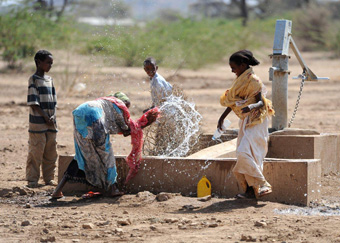
U.S. Navy photo by Mass Communication Specialist 2nd Class Michael Lindsey
“I was walking around speaking with Sailors and NGO folks aboard. A First Class Petty Officer was in charge, and they were all lined up to meet me. I asked the Petty Officer, ‘How was it?’ He said, ‘It was great, sir.’ And, I said, ‘Why was it great?’ A young Seaman jumped in and said, ‘I’ll tell you why it was great. We were in a country, which had a school with 1200 kids. They hadn’t had running water in seven years. Me and my guys went in there and five days later those kids had running water.’ The Seaman was so proud of their accomplishment. It was a life-changing experience, and I guarantee when he leaves or retires from the Navy, he’s going to remember that. Such experiences remind us that as put-upon as people sometimes feel they are, there are a lot of other folks who are having a much harder time,” comments Roughead.
It was that kind of caring attitude coupled with their Indonesian tsunami experience, which prompted the Navy to consciously start formulating its proactive humanitarian efforts. According to Roughead: “You could feel that a unique event had just taken place. The Indonesian tsunami was the largest humanitarian assistance effort ever undertaken, and you could see by the way the NGOs and militaries worked together – by the way the host nations worked together – that it was an incredible occurrence. Afterwards, when we were going through what happened – how it happened, what was good, what was not good – we knew we had a moment in time to try to keep those relationships alive. We also believed that if it happened again – and there was every expectation that something of that magnitude could happen again – it would be better if we had habitual relationships than a pick-up game, which is what the tsunami was. But, it was a great pick-up game.
“So, we said, ‘Ok, how do we do this better? Why don’t we take the hospital ship, deploy it again and bring back that capability to the area one year later.’ Our hospital ships are some of the most sophisticated hospitals on the planet. They’re the best trauma centers around. We said, ‘Let’s go back and also pick a few other places. Let’s invite NGOs and other countries.’ It was actually about 10 months later, and we made another trip back. That’s when we realized the benefit of doing what we were doing and the benefit of the relationships that had developed.
Building Relationships & Partnerships
“The next year we put the hospital ship into South America. But, we also wanted to go back to Indonesia, so we said, ‘Let’s try a different model,’ and we took one of our large amphibious ships. Even though the hospital ship is the iconic humanitarian assistance mission, a lot of the longer term development really gets done when we can bring an amphibious ship in with heavy road construction equipment and other really heavy equipment to do major work. You can fundamentally change a village or little town by rebuilding sewers and cleaning out tons of wells, or by providing heavier construction, if they need that, or by being able to transport more humanitarian cargo,” explains Roughead.
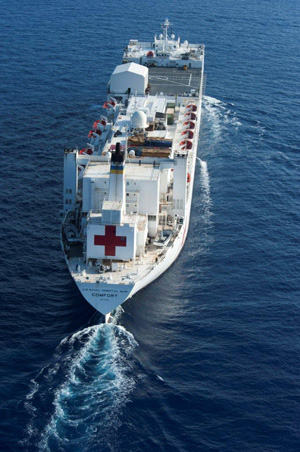
U.S. Air Force photo by Staff Sgt. Courtney Richardson
Given the demand on Navy medical personnel due to Iraq and Afghanistan, the Navy can source one of their two hospital ships per year for humanitarian assistance. Every year the hospital ship rotates with a large amphibious ship with a lighter medical contingent onboard. One year they travel to the Pacific; the next to South and Central America. This two-ship annual alternating mode has become the Navy’s current humanitarian model.
According to Roughead, the Navy has “looked at Africa for the hospital ship, but port access and location are just not optimum. So, we use one of our smaller amphibious ships, and that’s become the Africa Partnership Station (APS) that we deploy every year. Last year we pulled together an international team for APS, including many navy people from Africa. We brought them to Norfolk, which is the ship’s home port, to begin team integration. This would provide an opportunity as they crossed the Atlantic to practice and to plan for the various ports they’d be visiting.
“So, the team gets onboard; they’re about ready to go, and the Haiti earthquake takes place. We send the ship down to Haiti. A U.S. Navy ship shows up in Haiti with a large number of African and European naval officers onboard as part of the relief effort. They jumped right into it, and I’ve been told that some of those young officers became like rock stars in their country because of their participation. Again, tragedy reinforces the importance of what we do, and it provides training for how to be better prepared for future disasters.
“My intention is to keep pushing in the HA/DR direction. But, again, it’s a cooperative effort with NGOs and international partners. And, in fact, in the case of Africa Partnership Station, there have been a couple of European countries that have thrown their ships in. In addition, during last year’s Pacific Partnership, the Japanese had a ship in company providing humanitarian assistance. My view to all my counterparts is that if you sail and want some of our people aboard your ship, we’re good to go. The Europeans and Japanese have taken us up on it. It’s allowed us to bring navies together on a more equal footing. If I were to say, ‘Let’s all get together for an anti-air warfare exercise,’ we bring a lot of the big stuff to the table. But, if I say, ‘If you have doctors, I have doctors. If you have construction people, I have construction people,’ – that’s an equalizer and it allows us to come together,” explains Roughead.
Creating Common Ground
According to Roughead, the idea of the Global Maritime Partnership has really opened U.S. Navy eyes to issues countries deal with that America doesn’t even think about. Someone CNO admires greatly is the leader of the Senegal Navy, who’s “a wonderful gentleman. He cares deeply about his Navy, and he cares deeply about his country. He’s faced with one of the world’s most significant human migration/human trafficking issues. At our International Sea Power Symposium, we asked different countries to make presentations, and we asked Senegal to do so. I think everyone in the audience was stunned with what he’s trying to do with a small navy – to stem thousands of people who are involved in illegal migration in his waters. He was so understated in the magnitude of the issues; it was just extraordinary.
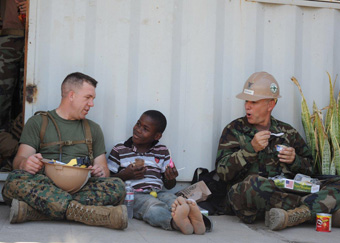
DoD photo by Mass Communication Specialist 2nd Class Eric C. Tretter, U.S. Navy
“We’re working with other navies and trying to develop teams to help understand what’s happening on the ocean – to be able to focus efforts more appropriately on where the problems are. Other countries have come in to offer assistance as well. The conference I mentioned, we sponsor it every two years in Newport at our War College. Four years ago 67 countries participated; this past October 102 countries participated – with more than 90 of my counterparts present. It was incredible. What was more impressive than the number was the range of discussions, the openness of the discussions and the camaraderie. We all have a very common bond, and it doesn’t make any difference if you’re a small navy or a large navy. You do what you do, and it’s kind of all the same; it’s just a matter of scale.
“When I look at the friends I’ve made – particularly over these past four years as CNO – it’s pretty incredible. I think the relationship building has created more openness and greater trust. It’s also opened up areas in places the U.S. hasn’t been before – that we haven’t really thought a lot about before. For example, I’ve been thinking about Africa and trying to learn as much as possible. It’s a place that will become increasingly more important, and we, quite frankly, don’t understand it. We don’t understand the magnitude and what I call, ‘the many Africas.’ How do we work with their navies? What are their issues? And, invariably, for many countries with small navies, they face the same thing. Trafficking, smuggling and illegal fishing are huge. When these large fishing ships come into a country’s economic zone and their navies don’t have the ability to police it, it’s like coming in and harvesting food off the land. Only they come in and scoop huge quantities of fish, which can be devastating to a country. That’s a very serious issue. So, as we work with other navies, countries and NGOs, I think we’re doing some good,” concludes Roughead.

